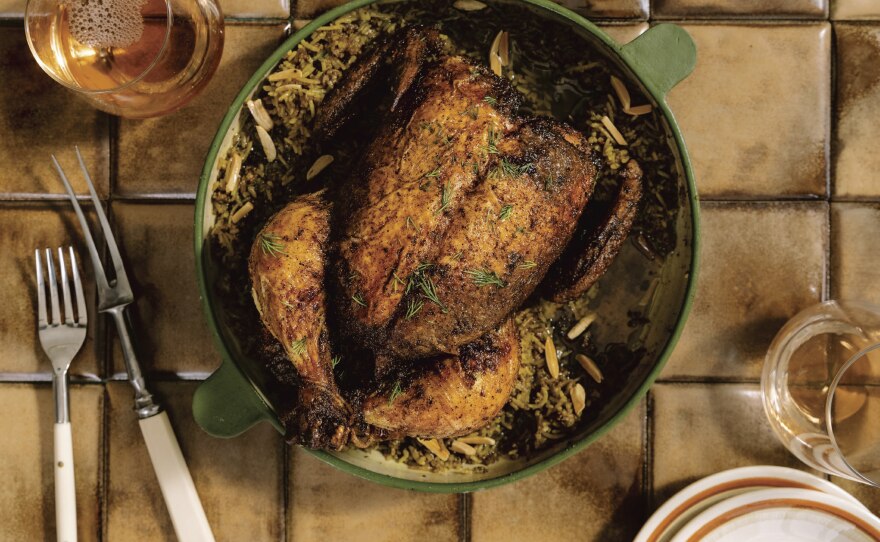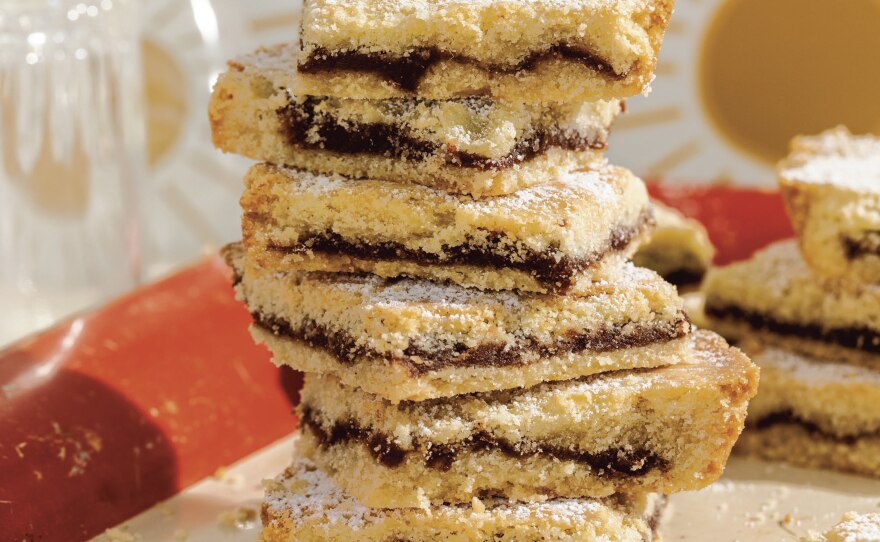As Ramadan, the holiest month in the Islamic calendar, comes to a close, many Muslims are celebrating Eid al-Fitr with their friends and family.
The festival closes out Ramadan and brings entire communities together for feasts and potlucks. But regardless of what size the gathering is, there's a safe bet that they will all include ma'amoul – the traditional semolina cookies that are often stuffed with dates or a nut mixture. Many Arab Muslims spend the entire last week of Ramadan making these holiday delights.
"The ma'amoul is kind of the claim to fame for a lot of Arabs celebrating Eid," says Reem Assil.
Assil is a Palestinian-Syrian chef from the San Francisco Bay area. In her debut cookbook Arabiyya: Recipes from the Life of an Arab in Diaspora, she recounts seeing the wooden molds into which the cookies are pressed come out each holiday season and working with her sisters to "make these labor-intensive cookies with gusto."
"Eid is really I think one of my favorite holidays because it is a coming together and celebrating life after a month of engaging in collective struggle," Assil says. "The act of abstaining from food and drink for a month with your community and to really get centered in what matters most, which is our own health and well-being and devotion to God for a lot of folks, but also for me to community. And then we get to celebrate together after successfully achieving this huge feat."

For the last five or so years, Assil has spent Eid al-Fitr working on special Ramadan treats in her bakery and restaurant locations, but this year she's getting to spend it with her family in the Los Angeles area, including her mother, who she plans on making ma'amoul with.
"I'm really excited this year to be able to celebrate Eid with her," Assil said. "My mom makes a more unique version called ma'amoul med, which the semolina cookie is like a bar. So you do layers of the semolina cookie, then the filling and then more semolina, and then you finish it off with powdered sugar."
In addition to the ma'amoul med, Assil is planning on making stuffed grape leaves and a lamb dish with spiced rice, which she says is an essential meal for the table. Recipes for all of those dishes can be found in her new cookbook.
Arabiyya, which translates to Arab woman in Arabic, is for anybody and everybody, Assil says, whether or not they know Arab cuisine. Many of the recipes in the book are massive platters meant for sharing at gatherings, and after two years of pandemic isolation, Assil hopes the book will inspire people to channel their own Arab hospitality and connect with others.
"The biggest tenet of Arab hospitality is that it's a virtue," Assil says. "You're supposed to make anyone who comes into your home, friends and strangers alike, feel like they are at ease and that they're safe and they have a sense of belonging."
Alongside the recipes and community building, Assil continues what has been her life-long work as a social justice advice by telling the history and sharing the varied experiences of Arab Americans.
"I wanted to really challenge people around the narrative of Arabs in this country," she says, while nodding to the increased anti-Muslim sentiment that happened after the Sept. 11th attacks. "It's like you either were the terrorist or the refugee or the victim. And I just I wanted to break all of those [tropes]. I wanted to really put forth a bold narrative of like, this is me and it's called Arabiyya, so it's really about being an Arab woman ... and how that informs the food that I cook."
"I really wanted to tell a story of resilience through the food. You know, hopefully the stories and the anecdotes really show how these recipes are sort of like clues as to how Arabs are able to create a home away from home, how they're able to build community, bring people in and turn hardships into really nourishing meals."

MA'AMOUL MED ∙ معمول مد
Orange and Espresso Date Cookie Bars
Makes 24 pieces
Dough
1½ cups/245g semolina flour
1⅓ cups/187g all-purpose flour
½ teaspoon/2g kosher salt
½ cup/60g confectioners' sugar
1 teaspoon/3g ground mahlab or amaretto extract (optional)
½ teaspoon/2g active dry yeast
1 cup/200g melted clarified butter or softened ghee
Filling
2 cups/225g pitted dates
1 tablespoon/15g softened clarified butter or ghee
1 teaspoon/3g espresso powder
½ teaspoon/2g ground cinnamon
½ teaspoon/2g orange zest
¼ teaspoon/2g ground cardamom
½ cup/120ml whole milk
2 teaspoons/12ml orange blossom water
Confectioners' sugar for dusting
To make the dough: In a medium bowl, combine the flours, salt, sugar, mahlab, and yeast. Add the butter to the dry ingredients and mix by hand or in a mixer until it forms a paste. Cover with plastic wrap or a dish towel and set aside to rest for 30 minutes.
To make the filling: While the flour mixture rests, immerse the dates in hot tap water and allow them to soak for about 10 minutes or until softened. Once they are soft, drain thoroughly and pulse them in the bowl of a food processor along with the butter, espresso powder, cinnamon, orange zest, and cardamom to form a sticky paste. Refrigerate until thoroughly chilled, about 15 minutes.
After 30 minutes, the dough will have hardened, so use a wooden spoon or other utensil such as a dough cutter to break up the dough a bit. Pour the milk and orange blossom water into the flour mixture and mix until smooth. Let stand at room temperature for another 30 minutes or up to 4 hours.
Preheat the oven to 300°F. Cut four sheets of parchment paper to fit an 8 by 11-inch sheet tray.
Form the dough into a ball and divide it into 2 equal parts.
Press half the dough onto one of the sheets of parchment. Layer a second piece of parchment on top and, using a rolling pin, roll an even ¼-inch crust to the paper's edges. Remove the top layer of parchment and flip the dough into the sheet tray. Re-use the sheets of parchment and roll out the second ball of dough. Set aside.
Sandwich the date filling between two new sheets of parchment and roll into an even ¼-inch layer, out to the paper's edges. Remove the top sheet and flip the date layer onto the dough. Remove the remaining parchment. Flip the remaining dough over the date filling and remove the final sheet of parchment.
Transfer the sheet tray to the oven and bake, rotating the tray once, until the bars are light golden brown on the edges, 30 to 35 minutes. Remove the tray from the oven and, when it is cool enough to touch, cut the bars into 2 by 2-inch squares. Transfer the tray to a wire rack to finish cooling. When the bars completely cool, dust with the confectioners' sugar before serving.
The bars can be stored in an airtight container in the refrigerator for up to 1 week.
Variation: Ashta Cream Filling
1 recipe clotted cream
½ cup blossom syrup
¼ cup crushed pistachios
To replace the date filling with the cream filling, follow the same assembly procedure but spread the clotted cream on the bottom layer of dough. Top with a second layer of rolled dough. Press gently and bake. After removing the pan from the oven, immediately drizzle the syrup over the top and sprinkle with the pistachios. Allow to set for 15 minutes at room temperature. When it's cool enough to touch, cut the bars into 2-inch squares and serve. The bars can be stored in an airtight container in the refrigerator for up to 1 week.
Reprinted with permission from Arabiyya: Recipes from the Life of an Arab in Diaspora by Reem Assil, copyright © 2022.
Published by Ten Speed Press, an imprint of Penguin Random House.
Copyright 2022 NPR. To see more, visit https://www.npr.org. 9(MDAzMjM2NDYzMDEyMzc1Njk5NjAxNzY3OQ001))







